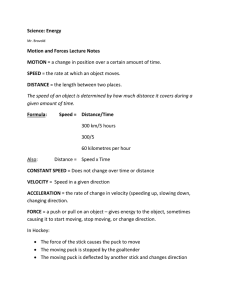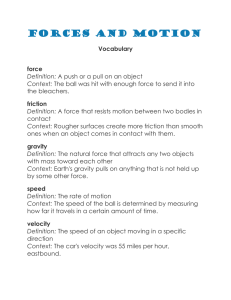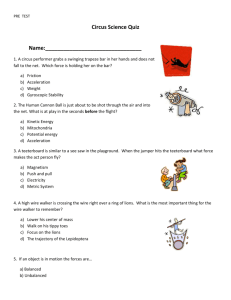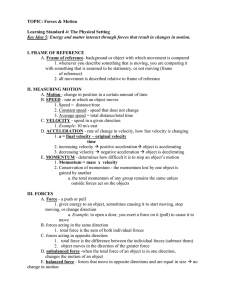object gravel
advertisement
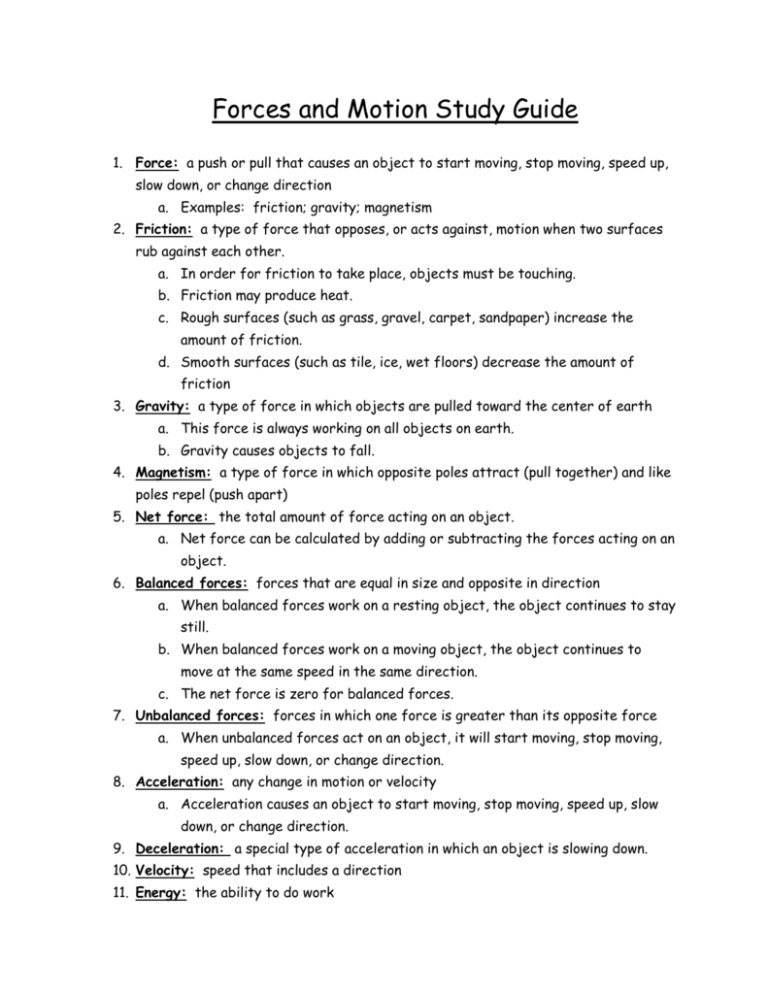
Forces and Motion Study Guide 1. Force: a push or pull that causes an object to start moving, stop moving, speed up, slow down, or change direction a. Examples: friction; gravity; magnetism 2. Friction: a type of force that opposes, or acts against, motion when two surfaces rub against each other. a. In order for friction to take place, objects must be touching. b. Friction may produce heat. c. Rough surfaces (such as grass, gravel, carpet, sandpaper) increase the amount of friction. d. Smooth surfaces (such as tile, ice, wet floors) decrease the amount of friction 3. Gravity: a type of force in which objects are pulled toward the center of earth a. This force is always working on all objects on earth. b. Gravity causes objects to fall. 4. Magnetism: a type of force in which opposite poles attract (pull together) and like poles repel (push apart) 5. Net force: the total amount of force acting on an object. a. Net force can be calculated by adding or subtracting the forces acting on an object. 6. Balanced forces: forces that are equal in size and opposite in direction a. When balanced forces work on a resting object, the object continues to stay still. b. When balanced forces work on a moving object, the object continues to move at the same speed in the same direction. c. The net force is zero for balanced forces. 7. Unbalanced forces: forces in which one force is greater than its opposite force a. When unbalanced forces act on an object, it will start moving, stop moving, speed up, slow down, or change direction. 8. Acceleration: any change in motion or velocity a. Acceleration causes an object to start moving, stop moving, speed up, slow down, or change direction. 9. Deceleration: a special type of acceleration in which an object is slowing down. 10. Velocity: speed that includes a direction 11. Energy: the ability to do work 12. Potential energy: energy that is stored. a. Potential energy is also called “energy of position.” b. Potential energy is at its highest when an object has not yet moved; it has the “potential” to move. c. Potential energy is increased if an object is held at a greater height. 13. Kinetic energy: energy of motion. a. Kinetic energy is at its highest when an object is moving. 14. Work: applying a force to an object to move that object over a distance. a. Work can be calculated by multiplying the force applied by the distance moved (W=Fd). b. In order for work to be done, the object must move! 15. Joules: the units for measuring work. 16. Newtons: the units for measuring force. 17. Inertia: the tendency of a resting object to remain at rest, or the tendency for a moving object to continue moving at a constant speed in a straight line, until a force acts on the object. a. Inertia is NOT a force! b. Objects with a greater mass have more inertia. c. Important examples: seatbelts; magician pulling tablecloth from underneath china dishes; ball rolling forward in wagon. 18. Momentum: how hard it is to slow down or stop a moving object. a. Momentum can be calculated by multiplying the object’s mass by the object’s velocity (M=mv). b. Objects with a greater mass have a greater momentum. 19. Machine: something that makes work seem easier by changing the size or the direction of a force. 20. Pulley: a type of simple machine; a good example is the system used to raise the flag on a flagpole. 21. Lever: a type of simple machine; examples include a crowbar, a see-saw, and the handle of an axe or shovel. 22. Inclined plane: a type of simple machine; a good example is a ramp or escalator. 23. Screw: a type of simple machine; a good example is the bottom of a lightbulb. 24. Wedge: a type of simple machine; examples include a doorstop, or the head of an axe. 25. Wheel and axle: a type of simple machine; used in manual pencil sharpeners, cars, bicycles, etc.



